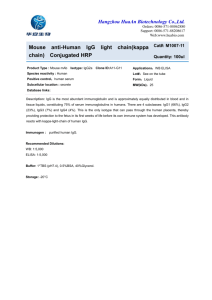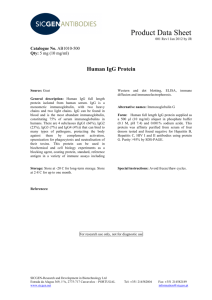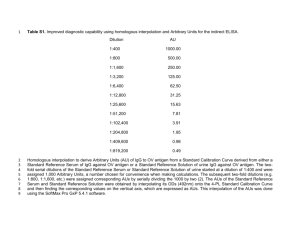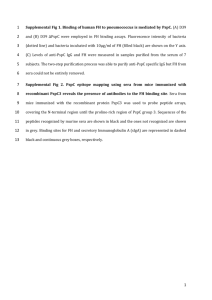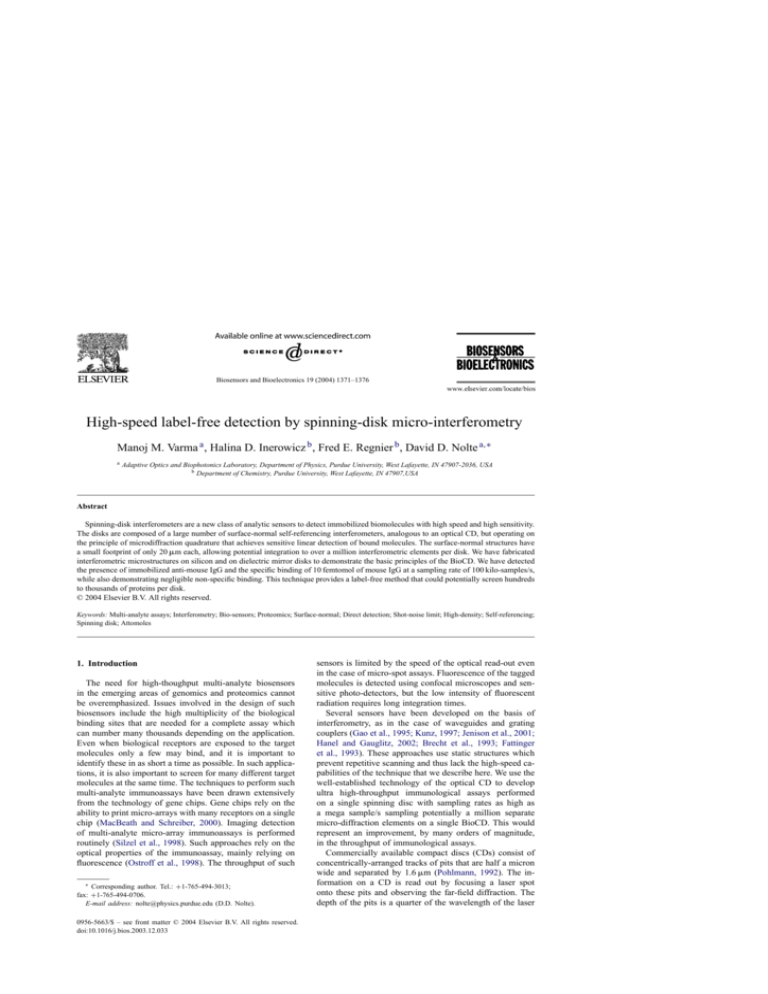
Biosensors and Bioelectronics 19 (2004) 1371–1376
High-speed label-free detection by spinning-disk micro-interferometry
Manoj M. Varma a , Halina D. Inerowicz b , Fred E. Regnier b , David D. Nolte a,∗
a
Adaptive Optics and Biophotonics Laboratory, Department of Physics, Purdue University, West Lafayette, IN 47907-2036, USA
b Department of Chemistry, Purdue University, West Lafayette, IN 47907,USA
Abstract
Spinning-disk interferometers are a new class of analytic sensors to detect immobilized biomolecules with high speed and high sensitivity.
The disks are composed of a large number of surface-normal self-referencing interferometers, analogous to an optical CD, but operating on
the principle of microdiffraction quadrature that achieves sensitive linear detection of bound molecules. The surface-normal structures have
a small footprint of only 20 m each, allowing potential integration to over a million interferometric elements per disk. We have fabricated
interferometric microstructures on silicon and on dielectric mirror disks to demonstrate the basic principles of the BioCD. We have detected
the presence of immobilized anti-mouse IgG and the specific binding of 10 femtomol of mouse IgG at a sampling rate of 100 kilo-samples/s,
while also demonstrating negligible non-specific binding. This technique provides a label-free method that could potentially screen hundreds
to thousands of proteins per disk.
© 2004 Elsevier B.V. All rights reserved.
Keywords: Multi-analyte assays; Interferometry; Bio-sensors; Proteomics; Surface-normal; Direct detection; Shot-noise limit; High-density; Self-referencing;
Spinning disk; Attomoles
1. Introduction
The need for high-thoughput multi-analyte biosensors
in the emerging areas of genomics and proteomics cannot
be overemphasized. Issues involved in the design of such
biosensors include the high multiplicity of the biological
binding sites that are needed for a complete assay which
can number many thousands depending on the application.
Even when biological receptors are exposed to the target
molecules only a few may bind, and it is important to
identify these in as short a time as possible. In such applications, it is also important to screen for many different target
molecules at the same time. The techniques to perform such
multi-analyte immunoassays have been drawn extensively
from the technology of gene chips. Gene chips rely on the
ability to print micro-arrays with many receptors on a single
chip (MacBeath and Schreiber, 2000). Imaging detection
of multi-analyte micro-array immunoassays is performed
routinely (Silzel et al., 1998). Such approaches rely on the
optical properties of the immunoassay, mainly relying on
fluorescence (Ostroff et al., 1998). The throughput of such
∗ Corresponding author. Tel.: +1-765-494-3013;
fax: +1-765-494-0706.
E-mail address: nolte@physics.purdue.edu (D.D. Nolte).
0956-5663/$ – see front matter © 2004 Elsevier B.V. All rights reserved.
doi:10.1016/j.bios.2003.12.033
sensors is limited by the speed of the optical read-out even
in the case of micro-spot assays. Fluorescence of the tagged
molecules is detected using confocal microscopes and sensitive photo-detectors, but the low intensity of fluorescent
radiation requires long integration times.
Several sensors have been developed on the basis of
interferometry, as in the case of waveguides and grating
couplers (Gao et al., 1995; Kunz, 1997; Jenison et al., 2001;
Hanel and Gauglitz, 2002; Brecht et al., 1993; Fattinger
et al., 1993). These approaches use static structures which
prevent repetitive scanning and thus lack the high-speed capabilities of the technique that we describe here. We use the
well-established technology of the optical CD to develop
ultra high-throughput immunological assays performed
on a single spinning disc with sampling rates as high as
a mega sample/s sampling potentially a million separate
micro-diffraction elements on a single BioCD. This would
represent an improvement, by many orders of magnitude,
in the throughput of immunological assays.
Commercially available compact discs (CDs) consist of
concentrically-arranged tracks of pits that are half a micron
wide and separated by 1.6 m (Pohlmann, 1992). The information on a CD is read out by focusing a laser spot
onto these pits and observing the far-field diffraction. The
depth of the pits is a quarter of the wavelength of the laser
1372
M.M. Varma et al. / Biosensors and Bioelectronics 19 (2004) 1371–1376
used for read-out. This depth difference between the pit
and the land results in a phase difference of between the
light reflected off the pit and the light reflected off the land
and leads to destructive interference at the detector, placed
along the optic axis in the far-field. Thus each pit acts as a
micro-interferometer, and an optical CD is a device with a
billion such micro-interferometers. Biomolecules placed directly on a commercial CD have been detected using bit error
rates during digital readout (La Clair and Burkart, 2003), but
this approach is not intrinsically interferometric. We previously demonstrated the importance of operating in interferometric quadrature to achieve high sensitivity (Varma et al.,
2003).
In this paper, we describe the fabrication of microstructures on silicon and dielectric mirror disks that act as microscopic interferometers, as on an optical CD, but operating
in quadrature with maximum linear sensitivity, unlike a digital CD. These interferometers are printed with antibodies
and binding of specific antigens is detected in the far-field
diffraction as an amplitude change that is sampled at high
speed as the disk rotates.
2. Fabrication and experimental setup
The BioCD is fabricated by evaporating gold ridges on
a 3 in. silicon wafer or on a 2 in. dielectric mirror disk in
a radial pattern as shown in Fig. 1. There are 1024 gold
lines arranged in a radial pattern of spokes. These gold
spokes are 20 m wide and are deposited to a thickness of
λ/8 = 79.1 nm, putting them in the quadrature condition for
read-out with a 632.8 nm He–Ne laser.
The primary advantage of this ridge-based design over a
design based on pits is that the gold ridges provide a sim-
Fig. 1. Schematic of the arrangement of the gold lines on the BioCD.
There are 1024 gold elements on a 2 in. disk. The spokes are illuminated
by a focussed Gaussian beam in a configuration where 50% of the intensity
falls on the land and 50% falls on the gold microstructure.
Fig. 2. Fluorescence image of immobilized BSA on the gold spokes of
the BioCD. The immobilization is achieved through a thiol bridge that is
highly selective to the gold spokes.
ple means to immobilize macromolecules such as antibodies on the interferometric structures. By using alkanethiols
as a bridge between the gold and the macromolecule, we
immobilize antibodies on the gold spokes alone, thus making a selective pattern of antibodies on the wafer. By using
polydimethylsiloxane (PDMS) stamps we immobilize antibodies on the gold pattern only in selected annuli of interest
(Bernard et al., 2000). These annuli can also be created by incubating annular regions of the thiolated substrate with antibodies in solution. Thus a single wafer can have regions with
and without antibodies, providing a means of control as we
test for antigen binding events in the regions with antibody.
To validate the selective immobilization on the gold microstructures, Fig. 2 shows a fluorescence image from bovine
serum albumin (BSA) immobilized on a BioCD. The BSA
molecules were tagged with fluorescein. In the procedure for
immobilization, the BioCD was treated with a 10 mM solution of hexa-decane-thiol in ethanol for 12–15 hours that
deposited a thiol layer on the gold spokes. The thiolated disk
was then treated with fluorescein-conjugated bovine serum
albumin (200 g/ml), immobilizing BSA selectively on the
gold spokes. As the fluorescence image shows, the pattern
of BSA is well defined and demonstrates the effectiveness
of the gold-ridge approach in immobilizing antibodies.
Interferometers have a universal response curve, shown
in Fig. 3a, with a half-intensity point defined by quadrature,
when the signal and the reference waves are out of phase
by ninety degrees and when the intensity versus phase has
the highest slope. The calculated far-field diffraction patterns for three ridge heights h = 0, λ/8 and λ/4 (corresponding to land, quadrature, and conventional digital CD) are
shown in Fig. 3b. Maximum linear sensitivity to small optical perturbations is achieved by operating the interferometer
near quadrature. Shot noise-limited detection of optical path
length changes down to a billionth-lambda is achievable under these conditions.
When a macromolecule is immobilized on a spoke, it
introduces an additional phase (neglecting near-field effects)
M.M. Varma et al. / Biosensors and Bioelectronics 19 (2004) 1371–1376
1373
of
δφ =
4π
(n − 1)d
λ
(1)
where n is the effective refractive index of the biolayer and
d is the biolayer thickness. This additional phase modifies
the power detected at quadrature according to
δP = P0
2π
(n − 1)d
λ
(2)
where P0 is the power detected when the beam is incident
on the land alone. The calculated response of the far-field
diffraction to the additional phase load of a single monolayer of immobilized molecules is shown in Fig. 3c for ridge
heights of h = 0, λ/8 and λ/4. The quadrature condition
clearly leads to the strongest change in the signal. The signal
is also linear in d, while for CDs the signal is quadratic in d.
3. Results and discussion
A schematic of the experimental layout is shown in Fig. 4.
The laser beam is focused by a 10× objective lens onto the
gold microstrips on the BioCD placed on a photoresist spinner. An image plane of the spoke structure is formed at a
distance of 0.6 m from the disk with a magnification of M =
200. A 10 cm focal length lens is then used to perform a
Fourier transform of the image of the gold microstrip to obtain the far-field signal at the Fourier plane. A photodetector
placed at the Fourier plane monitors the far-field signals. A
25 m pinhole is used to selectively pass the diffraction peak
on the optic axis while blocking the higher-angle diffraction.
The signal from the photodetector is sent to a preamplifier
and then to a digital oscilloscope where direct time traces
of the probe laser from the disk are monitored and captured
for analysis. To achieve high sampling rates, the BioCD is
mounted on a spinning platform capable of achieving speeds
on the order of 6000 rpm, and detection is done while the
device is spinning. We use a conventional photo-resist spinner (model P6204, SCS) as the rotating platform.
The 632.8 nm collimated He–Ne laser beam is focused
to a waist diameter of between 40 and 80 m at the disk
surface. As the BioCD rotates at 6000 rpm, quadrature is
achieved when the beam symmetrically straddles the gold
Fig. 3. (a) Universal response curve of a two-port interferometer shown
here as a function of the height of the microstructure. A conventional
digital CD alternates between the land and the point of destructive interference at λ/4. For the BioCD, quadrature is achieved at ridge heights of
λ/8 and 3λ/8, where the maximum slope occurs. (b) Far-field diffraction
patterns are shown for the cases of h = 0, λ/8 and λ/4. (c) Differential intensity response to a monolayer of immobilized biomolecules with
mean height of 8 nm.
Fig. 4. Schematic of the experimental setup to detect the far-field diffraction from the BioCD.
1374
M.M. Varma et al. / Biosensors and Bioelectronics 19 (2004) 1371–1376
Peak-to-Peak Voltage (V)
0.12
NoAb
Ab
Ab+Ag
0.10
0.08
0.06
0.04
0.02
0.00
0
50
100
150
200
Spoke Number
Fig. 6. Detection of the binding of antigen (mouse IgG) on a silicon
BioCD. In the figure, ‘Ab’ refers to anti-mouse IgG and ‘Ag’ refers to
mouse IgG. The change caused by the binding of the antigens is about
25%. This result clearly demonstrates the detection of binding.
Fig. 5. Modulation of the far-field signal in the presence of an immobilized
macro-molecule film. The data are offset to show the traces more clearly.
spoke. At other times the beam merely reflects off the land.
At quadrature, the far-field diffraction intensity drops by approximately 50% compared to the intensity from the bare
substrate (in the case of a laser mirror substrate). This results in the formation of peaks and dips in the oscilloscope
trace, with the dips representing the interferometric signal
in quadrature.
Fig. 5 shows the raw signal captured as a function of time
by the oscilloscope in the presence of BSA immobilized
on the gold spokes on a silicon wafer compared to a wafer
with only gold (the offset between the curves is simply for
ease of viewing). There is a clear decrease in the peak–peak
difference of the signal caused by the immobilization of
BSA on the gold spokes. When a silicon wafer is used as the
substrate, the land has a 34% reflectance compared to the
100% reflectance of the gold microstructure. This situation
flips the order of land and quadrature reflectance, with the
land occurring as the dips and quadrature as the peaks in the
oscilloscope time trace. When the BSA binds to the gold,
it decreases the intensity of the peaks, and thus causes a
decrease in the peak–peak signal values, as observed in the
figure.
disk is exposed to antibody and then to antigen, demonstrating the binding of the specific antigen to the immobilized
antibody.
3.2. Non-specific binding
An important performance parameter for biochips is
the strength of non-specific binding of the antibodies to
non-target molecular species. Non-specific binding can be
quantified by detecting a signal level change for antigens
not specific to the antibody. We immobilized the BioCD
with anti-mouse IgG and exposed part of the disk to mouse
antigen, which is the specific antigen in this case, and the
remaining part to BSA, which is a non-specific species.
Fig. 7 shows the results of the non-specific binding experiments on silicon. The expected change in the signal from
the region that was exposed to mouse IgG, the specific
antigen, indicates binding. However, the region exposed to
3.1. Specific binding
To test the ability of the BioCD to detect the presence of
antigens in an sample, we immobilized anti-mouse IgG on
an annular region roughly covering half the area of a silicon
substrate with h = λ/8 gold spokes. We incubated a second
annular region, contained fully within the first annular region, with a solution of specific Mouse IgG. Fig. 6 shows
the experimental peak–peak values obtained as a function
of time. The overall amplitude modulation is caused by disk
wobble. There are systematic changes in the signal when the
Fig. 7. Results of the non-specific binding experiments on a silicon BioCD
showing small non-specific binding signal modulation.
M.M. Varma et al. / Biosensors and Bioelectronics 19 (2004) 1371–1376
1375
leaving the peaks (from the land) unchanged. Exposure to
the non-specific antigen, rabbit IgG, causes no additional
phase change and registers no change in signal. However,
subsequent exposure to the specific antigen, mouse IgG,
causes an additional increment in the signal. Thus, the detection scheme is specific to the target analyte, and is not
blocked by previous exposure to the non-specific antigen.
4. Conclusions and future work
Fig. 8. Track layout for the non-specific binding and activity-blocking
experiments on a dielectric mirror substrate. The specific antigen is mouse
IgG. The non-specific antigen is rabbit IgG.
BSA, the non-specific antigen, shows no appreciable signal
change, verifying low non-specific binding. In the figure,
‘Ab’ refers to anti-mouse IgG and ‘Ag’ refers to mouse IgG.
Experiments on a laser mirror provide a more stringent
test of non-specific binding. The track sequence is shown
in Fig. 8. The non-specific species in this case is rabbit
IgG which is morphologically similar to the specific antigen mouse IgG and hence may be more likely to bind
non-specifically. An important aspect in this experiment
is the exposure to the specific antigen after exposure to
non-specific antigen. This not only tests for non-specific
binding, but also tests for blocking or inactivation of the
antibody by initial exposure to the non-specific species.
Such interference would prevent a multi-analyte approach.
The results of the experiment are shown in Fig. 9 for only a
selected number of spokes. For gold alone, the order of the
peaks and dips are opposite that for silicon (compare Fig. 5)
because of the high substrate reflectivity. The immobilization of the antibody lowers the valleys (at quadrature) while
Fig. 9. Detection of Mouse IgG, and specificity of the detection scheme.
The dielectric BioCD is printed with anti-mouse IgG on a dielectric mirror
substrate. Incubation with non-specific rabbit IgG produces no change
in the far-field diffraction intensity. Subsequent incubation with specific
mouse IgG produces a further drop in the far-field diffraction intensity at
quadrature.
The number of detected antigen molecules is estimated
by considering a monolayer of immobilized antibody on a
spoke (verified separately by AFM measurements) illuminated within the beam waist of the laser. This is around 107
molecules per spoke or about 10 femtomol per track. The
sensitivity of the system described in this paper is estimated
from an assumed S/N = 100 to be 105 molecules per spoke
per track, or 100 attomol. The ultimate detection sensitivity in the shot-noise limit can be derived analytically. The
signal-to-noise ratio for a phase load dφ of Eq. (1) is
S
1 P0
=
ηd δφ2
N
2BW hν
(3)
where BW is the detection bandwidth, P the input laser
power and ηd the quantum efficiency of the detector. For
a signal-to-noise ratio equal to 2, this leads to a minimum
detectable thickness
BWhν
λ
dmin =
(4)
2π(n − 1) ηd P0
For nominal values of BW = 1 kHz, λ = 633 nm, n =
1.35, ηd = 0.7 and P0 = 10 mW, this leads to a minimum detectable thickness of dmin = 60 fm. For an antibody
molecule with a diameter of 8 nm, this corresponds to merely
100 molecules per spoke per track, or about 0.1 attomol
per track. At this level of sensitivity, it is clear that surface
roughness of the disk would be the limiting noise source,
preventing the shot-noise limit from being attained. However, estimates of noise contributions from surface roughness of optical flats indicate that numbers down to attomol
of analyte molecules may be detectable per track using this
approach. Such performance remains to be experimentally
demonstrated.
In conclusion, we have successfully demonstrated the
effectiveness of an interferometric approach for rapid and
simultaneous multi-analyte detection. This BioCD technique has the distinct advantage of being integrated in
a high-speed sensor in an optical disk format delivering high-throughput screening capabilities. One possible
way to implement multi-analyte capabilities would be using micro-fluidic delivery channels for protein patterning
(Papra et al., 2001). Such micro-fluidic delivery systems
can take advantage of the centrifugal force provided by the
spinning disk. The same channels could be used for detection in a “wet” environment. This approach would also be
1376
M.M. Varma et al. / Biosensors and Bioelectronics 19 (2004) 1371–1376
useful in applications other than immunoassays including
proteomics, genomics and drug screening among others.
References
Bernard, A., Renault, J.P., Michel, B., Bosshard, H.R., Delamarche, E.,
2000. Microcontact printing of proteins. Adv. Mater. 12, 1067–1070.
Brecht, A., Gauglitz, G., Polster, J., 1993. Interferometric immunoassay
in a Fia-system—a sensitive and rapid approach in label-free immunosensing. Biosens. Bioelectron. 8, 387–392.
Fattinger, C., Koller, H., Schlatter, D., Wehrli, P., 1993. The difference
interferometer—a highly sensitive optical probe for quantification of
molecular-surface concentration. Biosens. Bioelectron. 8, 99–107.
Gao, H., Sanger, M., Luginbuhl, R., Sigrist, H., 1995. Immunosensing with
photo-immobilized immunoreagents on planar optical wave guides.
Biosens. Bioelectron. 10, 317–328.
Hanel, C., Gauglitz, G., 2002. Comparison of reflectometric interference
spectroscopy with other instruments for label-free optical detection.
Anal. Bioanal. Chem. 372, 91–100.
Jenison, R., Yang, S., Haeberli, A., Polisky, B., 2001. Interference-based
detection of nucleic acid targets on optically coated silicon. Nat.
Biotechnol. 19, 62–65.
Kunz, R.E., 1997. Miniature integrated optical modules for chemical and
biochemical sensing. Sens. Actuators B 38/39, 13–28.
La Clair, J.J., Burkart, D.M., 2003. Molecular screening on a compact
disk. Org. Biomol. Chem. 1, 3244–3249.
MacBeath, G., Schreiber, S.L., 2000. Printing proteins as microarrays for
high-throughput function determination. Science 289 (5485), 1760–
1763.
Ostroff, R.M., Maul, D., Bogart, G.R., Yang, S., Christian, J., Hopkins,
D., Clark, D., Trotter, B., Moddel, G., 1998. Fixed polarizer ellipsometry for simple and sensitive detection of thin films generated
by specific molecular interactions: applications in immunoassays and
DNA sequence detection. Clin. Chem. 44 (9), 2031–2035.
Pohlmann, K.C., 1992. The Compact Disc Handbook, second ed. A.-R.
Editions Inc.
Papra, A., Bernard, A., Juncker, D., Larsen, N.B., Michel, B., Delamarche,
E., 2001. Microfluidic networks made of poly(dimethylsiloxane), Si
and Au coated with polyethylene glycol for patterning proteins onto
surfaces. Langmuir 17, 4090–4095.
Silzel, J.W., Cercek, B., Dodson, C., Tsay, T., Obremski, R.J., 1998.
Mass-sensing, multianalyte microarray immunoassay with imaging
detection. Clin. Chem. 44 (9), 2036–2043.
Varma, M.M., Nolte, D.D., Inerowicz, D.H, Regnier, E.F., 2003.
High-speed label-free multi-analyte detection through microinterferometry. Proc. SPIE 4966 (9), 58–64.

